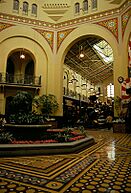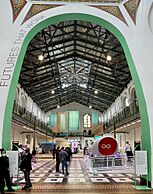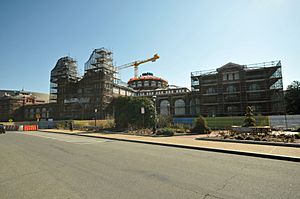Arts and Industries Building facts for kids
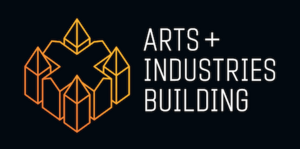 |
|
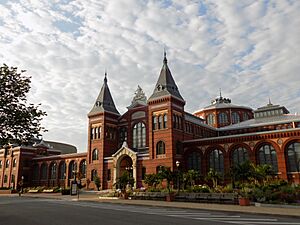 |
|
| Lua error in Module:Location_map at line 420: attempt to index field 'wikibase' (a nil value). | |
| Former name | United States National Museum |
|---|---|
| Established | 1879 |
| Location | 900 Jefferson Drive SW, Washington, D.C. |
|
Arts and Industries Building
|
|
| Built | 1881 |
| Architect | Cluss & Schulze; Meigs, Montgomery |
| Architectural style | Renaissance Revival |
| NRHP reference No. | 71000994 |
| Significant dates | |
| Added to NRHP | November 11, 1971 |
| Designated NHL | November 11, 1971 |
The Arts and Industries Building is the second oldest museum of the Smithsonian Institution in Washington, D.C.. Only The Castle is older. This building was first called the National Museum. It was built so the Smithsonian could properly show its growing collections to the public.
The building was designed by architects Adolf Cluss and Paul Schulze. It opened in 1881 with a special party for President James A. Garfield. In 1971, it was named a National Historic Landmark. The building was closed for repairs from 2004. It reopened in 2021 with a special exhibit called Futures.
Contents
About the Building
The Arts and Industries Building was placed a bit further back from the National Mall. This was done so it would not block the view of the Smithsonian Castle from the Capitol. The building was designed to be balanced on all sides. It has a central rotunda, which is a round room with a dome.
The outside of the building has colorful brick patterns. A sculpture called Columbia Protecting Science and Industry is above the main entrance. This sculpture was made by Caspar Buberl. Inside, light comes in through skylights and high windows. An iron roof covers the building. In 1883, the outside bricks were changed to a brighter maroon color.
The building has four main sections, called pavilions. Each pavilion is about 40 feet (12 meters) square and three stories tall. These sections surround the central rotunda. Lower parts of the building were added around the pavilions. In the 1890s, the wooden floors were replaced. This was because people complained about dampness and poor health. Balconies were added between 1896 and 1902. This helped create more space. A tunnel was built in 1901 to connect to the Smithsonian Institution Building next door.
Building History
The 1800s
The idea for the building came from the 1876 Philadelphia Centennial Exposition. Congress said that if money from the exhibition was paid back, some of it could be used for a new museum building. The exhibition was very successful, and the loan was paid back quickly.
So, in 1878, a plan was made to build a new museum. General Montgomery C. Meigs created the plans. His ideas were based on buildings from other big exhibitions. Funds were approved in 1879. The design was then carried out by Cluss and Schulze.
While the building was being built, many items from the Philadelphia Centennial Exposition arrived. There were "sixty box cars worth" of donations. These items were too many for the Smithsonian Institution Building. So, they were stored temporarily in another building nearby.
The first big event in the new National Museum Building was a party. It was the Inaugural Ball for President James Garfield and Vice President Chester A. Arthur. This happened on March 4, 1881. A temporary wooden floor was put down. Two electric lights were placed in the Rotunda. Thousands of bins for hats and coats were set up. Many gas lights were installed. The halls were decorated with flags and seals. A huge "Statue of America" stood in the Rotunda. It held an electric light, showing America's progress.
Eight months later, the museum officially opened to the public. It had 80,000 square feet of space for exhibits. There were special mahogany display cases. The halls showed exhibits on many topics. These included geology, animals, medicine, and history. There were also displays on technologies like printing and textiles. George Brown Goode, a historian, helped set up a section for arts and industries. Materials from the museum were sent to many exhibitions. This helped teach people about the country's history.
The 1900s
In 1910, the collections about natural history moved. They went to the new National Museum of Natural History. The old National Museum Building was then renamed the Arts and Industries Building.
More exhibits were moved in 1964. They went to the National Museum of History and Technology. This museum is now called the National Museum of American History.
In 1975, the building closed to the public. Its remaining exhibits were moved to the new National Air and Space Museum. The building was then repaired for about a year. This cost $4.5 million. Air conditioning was also added.
In May 1976, the Arts and Industries Building reopened. It featured an exhibit called 1876: A Centennial Exhibition. This show displayed the artifacts from the Philadelphia Exposition. These were the items the building was originally built to hold. Later, temporary exhibits and a children's theater were added. The theater was known as the Discovery Theater.
The 2000s and Today
By 1995, the building was in poor condition. There were worries it might close. By 2000, plastic sheets were put up to protect visitors from falling debris. In 2004, the building closed to the public. It was not clear when it would reopen because funding for repairs was uncertain.
Because of its uncertain future, the National Trust for Historic Preservation listed it as one of America's Most Endangered Places in 2006. In 2009, it received $25 million for renovation work. This money came from a special government act.
In 2010, work began to fix the building's outer structure. A full restoration was expected to cost $200 million. This included $65 million just for structural repairs. It was thought the work would finish by 2014. However, in January 2014, the Smithsonian said the building would stay closed. They mentioned concerns about funding. But on April 12, 2015, a Smithsonian official said about 40 percent of the building would reopen in fall 2015. It would be used for short-term exhibits. Officials said the building was structurally safe. Small updates were made to bathrooms, the heating and cooling system, and paint. The official said the building would not fully reopen yet. Its long-term future was still being decided.
After 2015, the building was sometimes used for special events. One example is the Smithsonian Folklife Festival. The Arts and Industries Building officially reopened in November 2021. This was its first exhibit since 2004. The exhibit was called Futures and ran until July 2022. After that, the building was scheduled for major renovations. These renovations would allow it to open permanently as early as 2028. The building was also considered as a possible home for the National Museum of the American Latino or the Smithsonian American Women's History Museum.
The building has hosted many exhibits and artists. For example, Catie Cuan, a Futurist-in-Residence, performed at the closing of the Futures exhibit on July 6, 2022.
More to Explore
- List of National Historic Landmarks in Washington, D.C.
- National Register of Historic Places listings in central Washington, D.C.
- Architecture of Washington, D.C.




